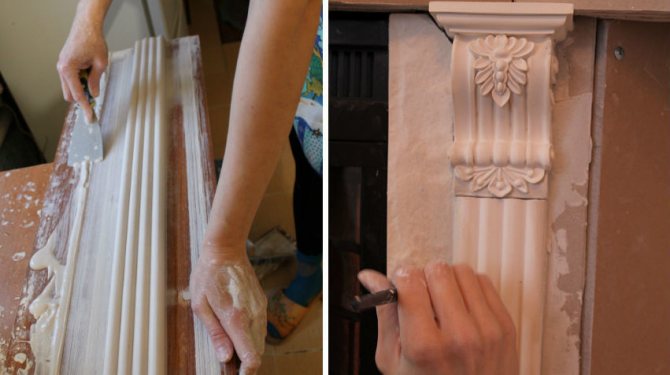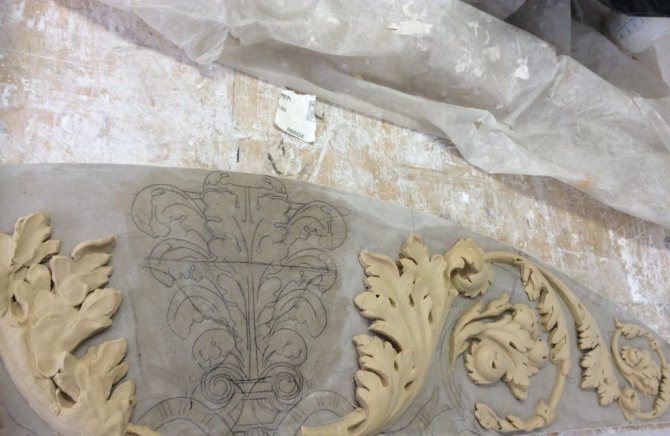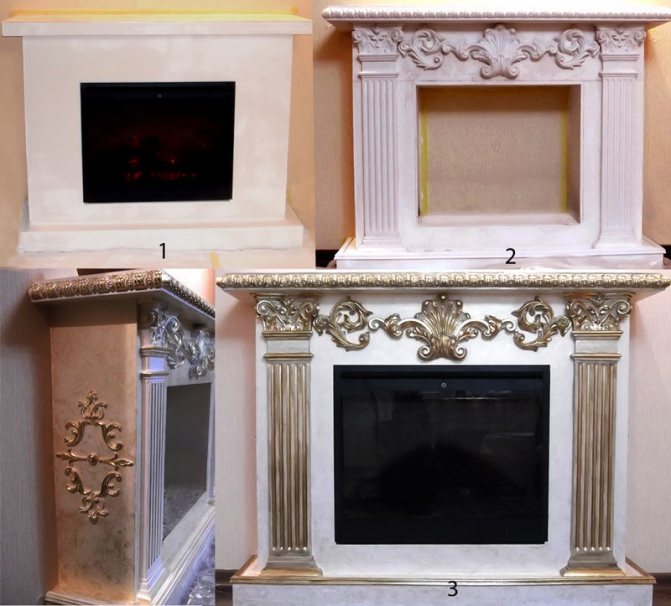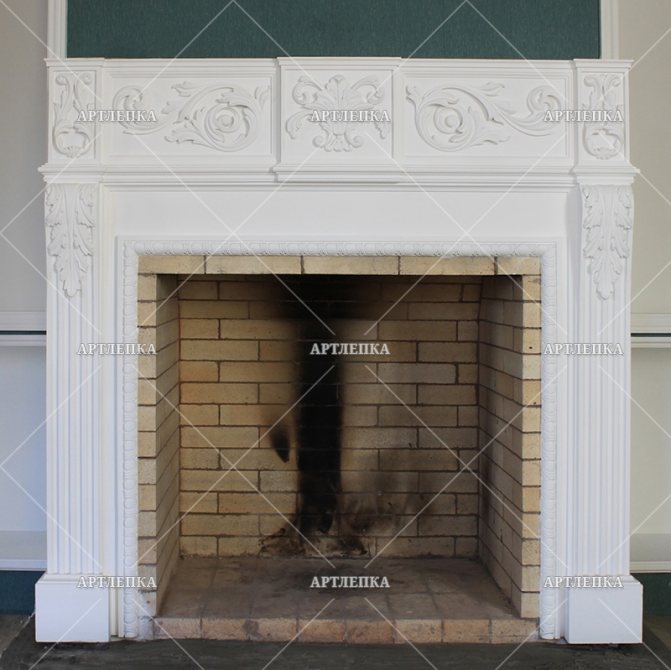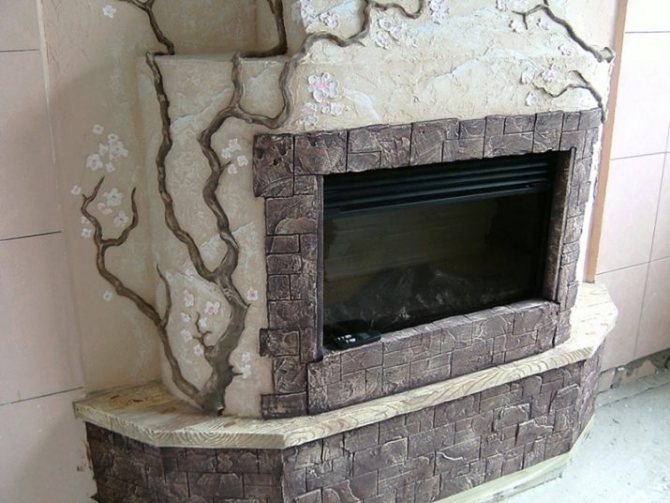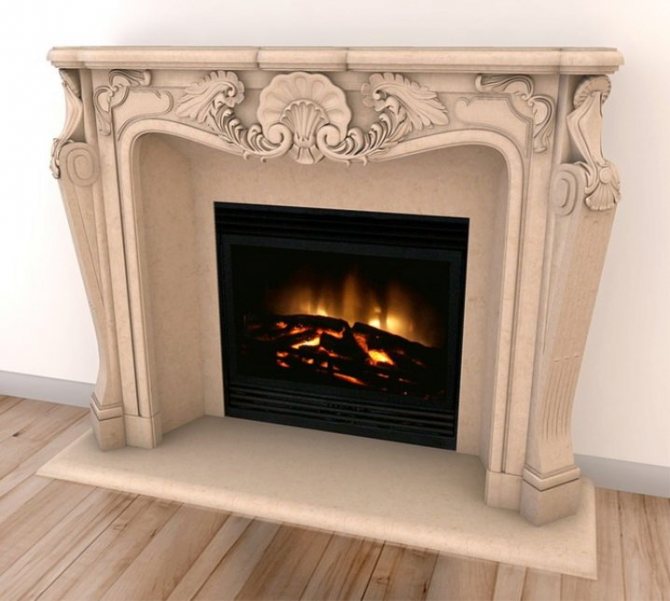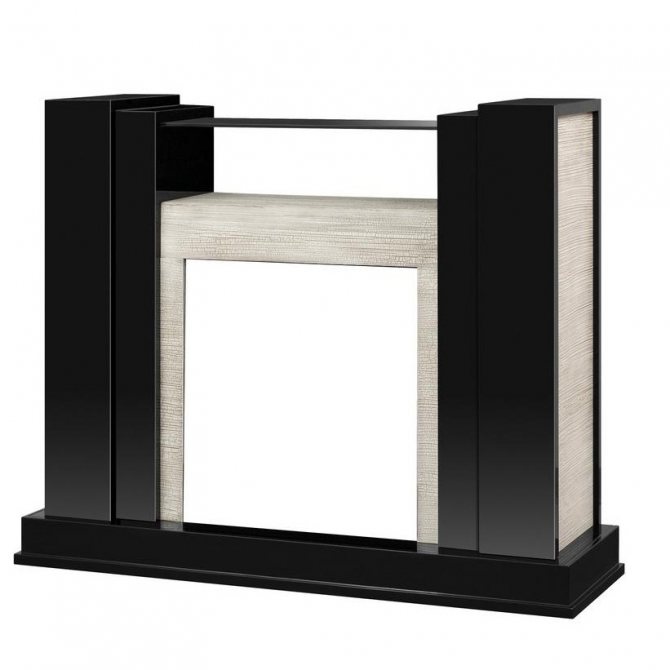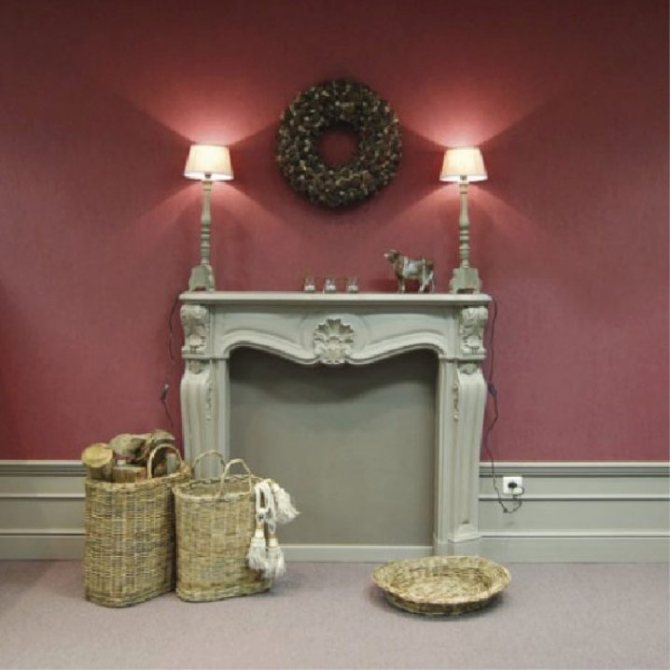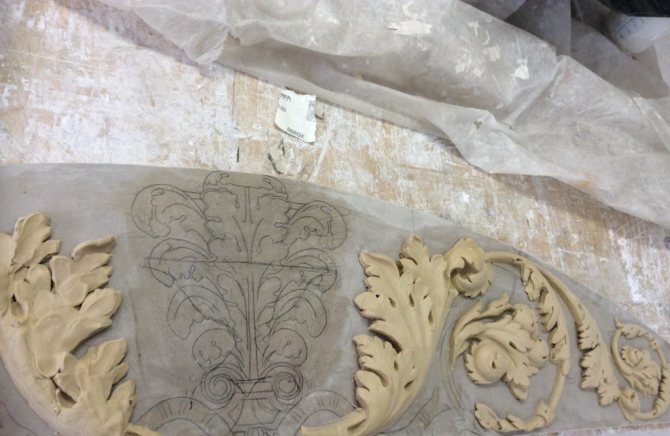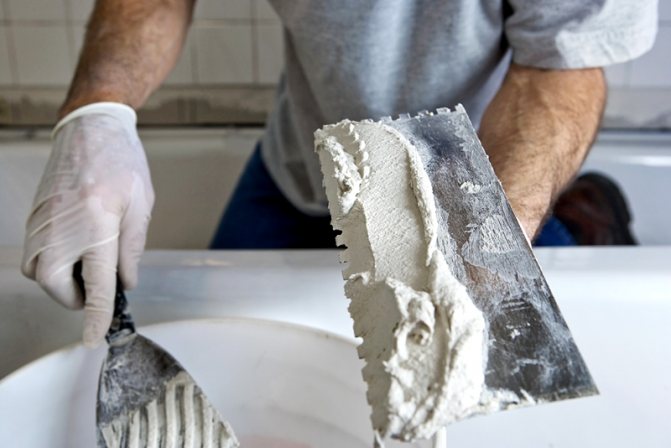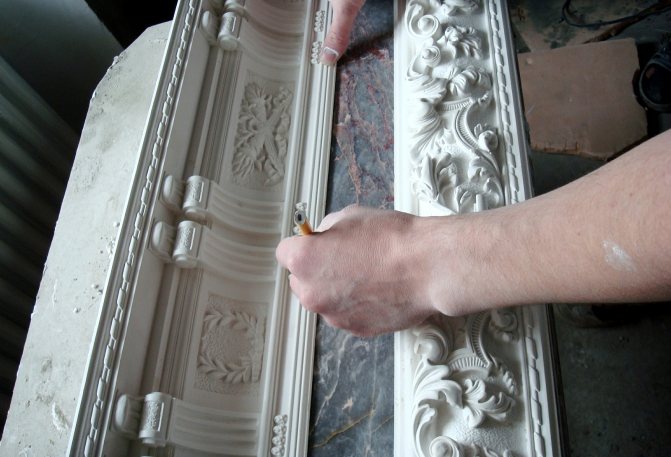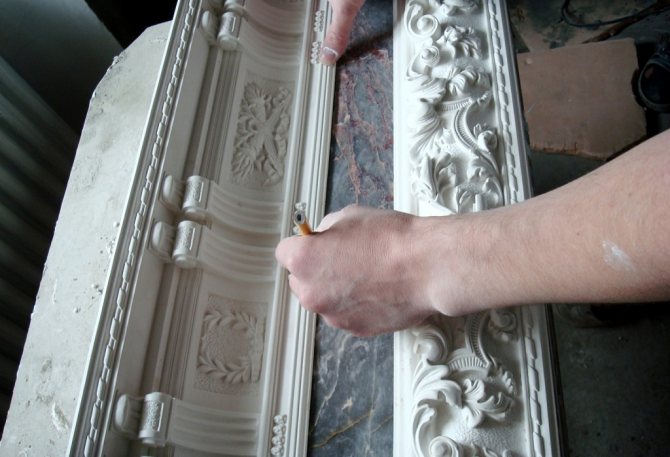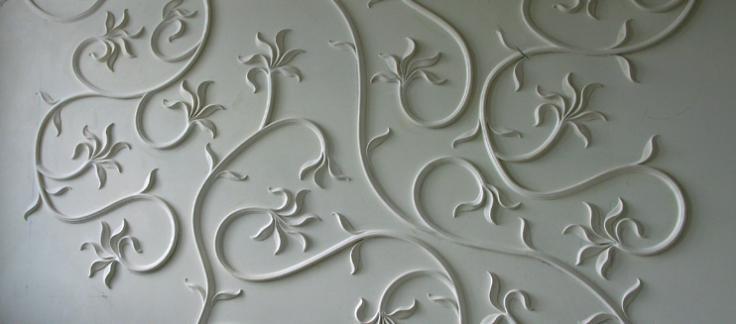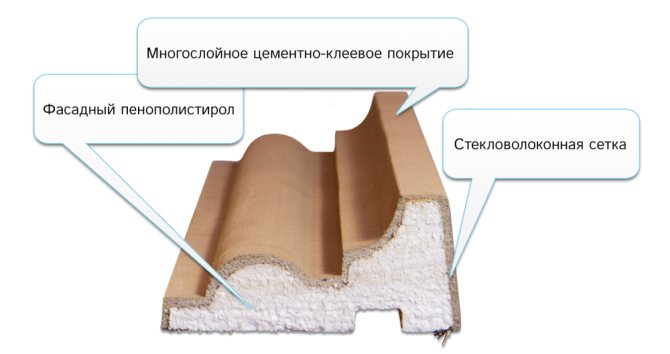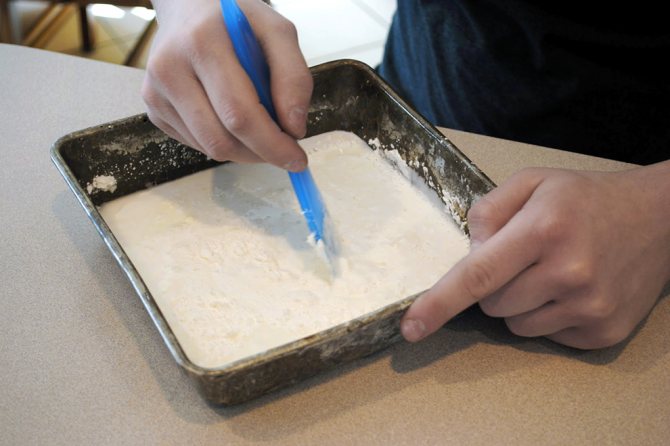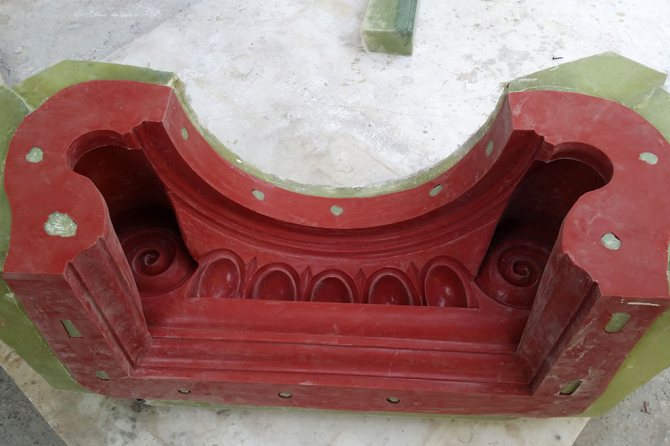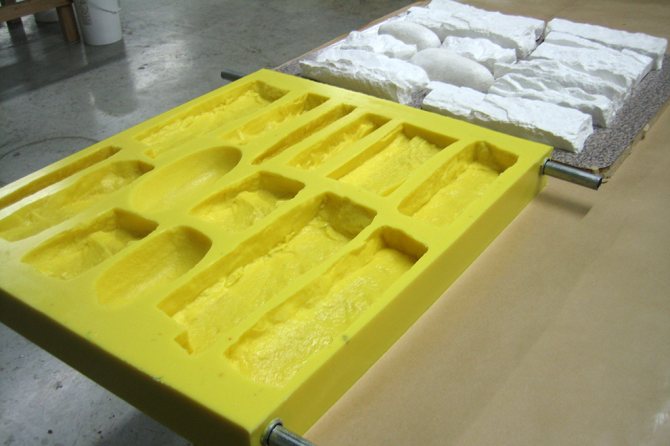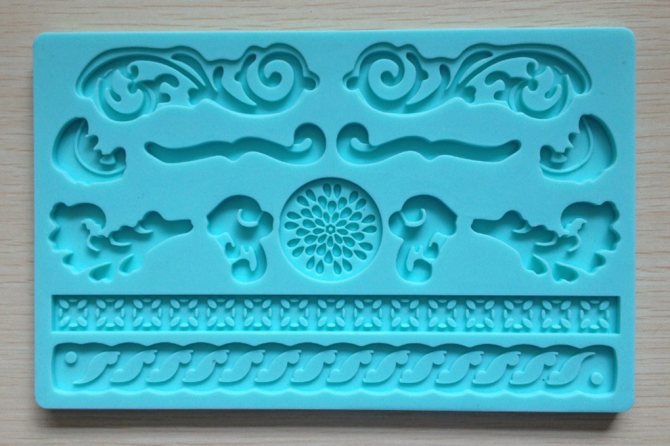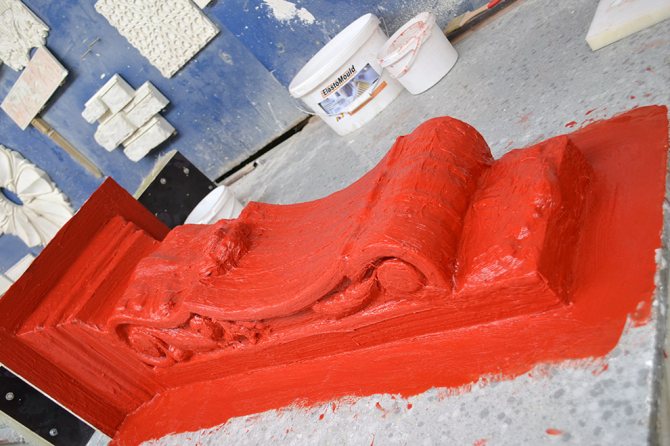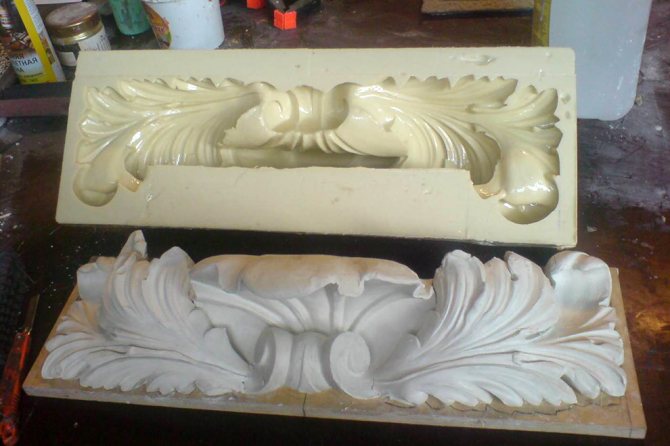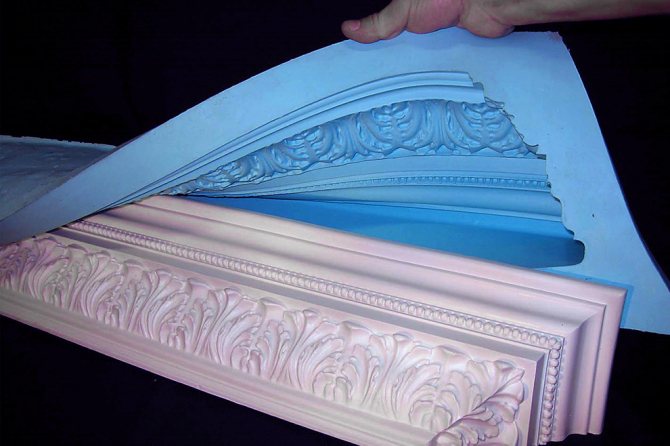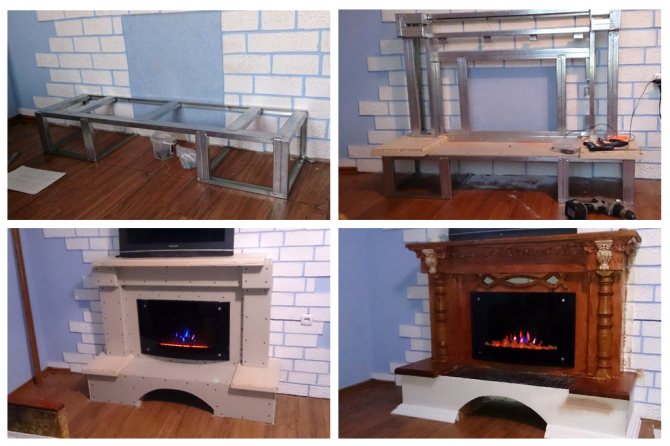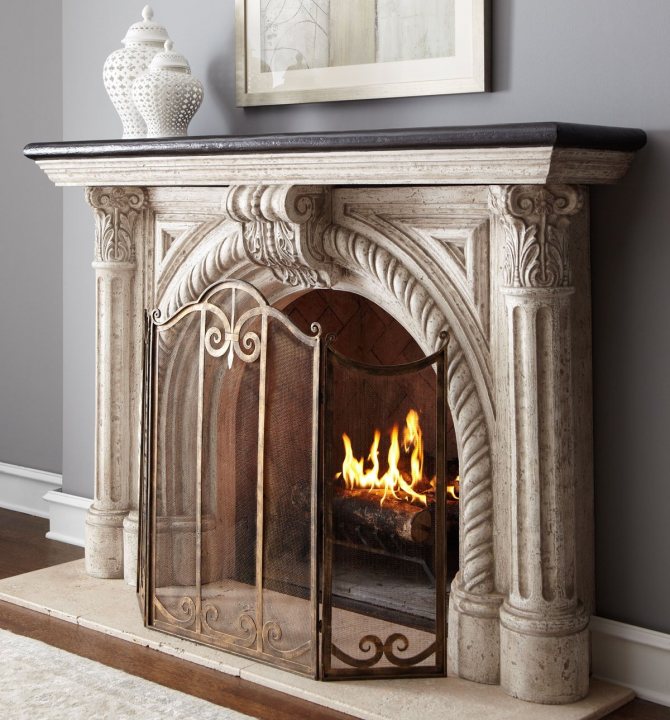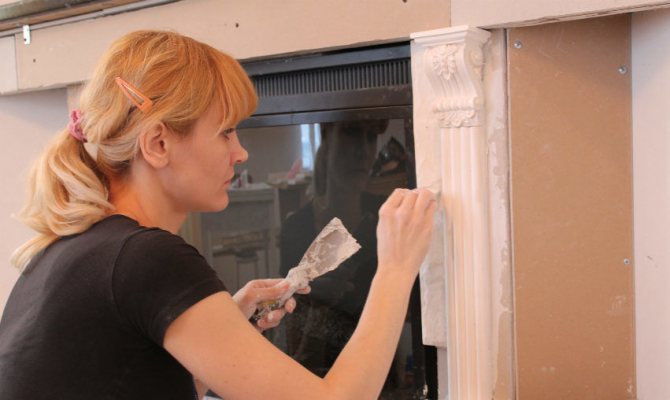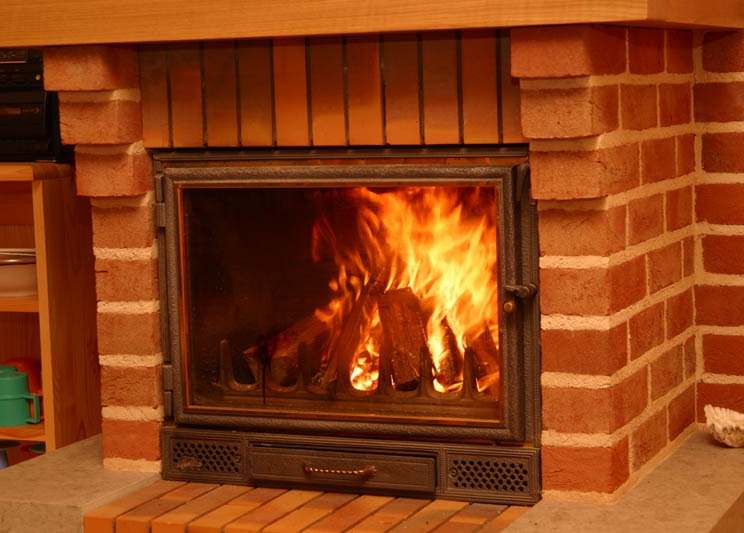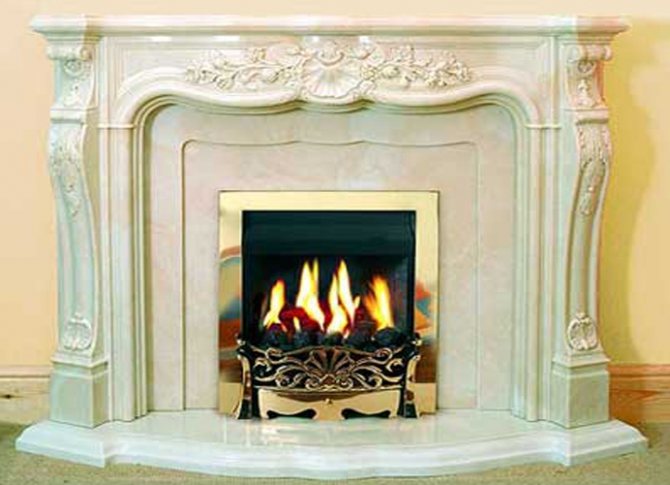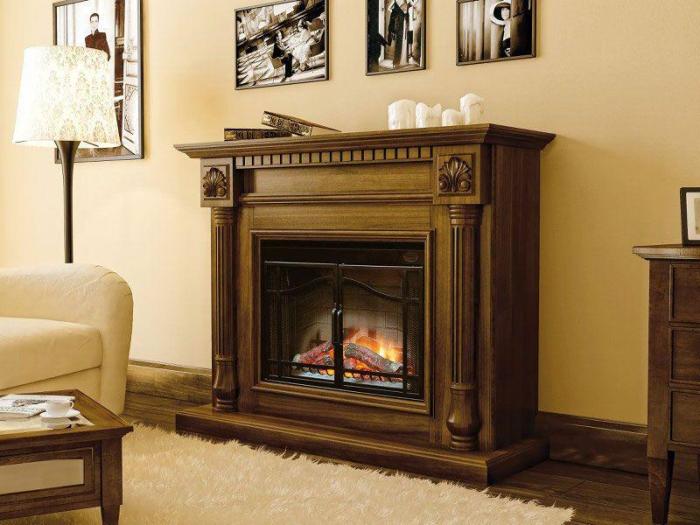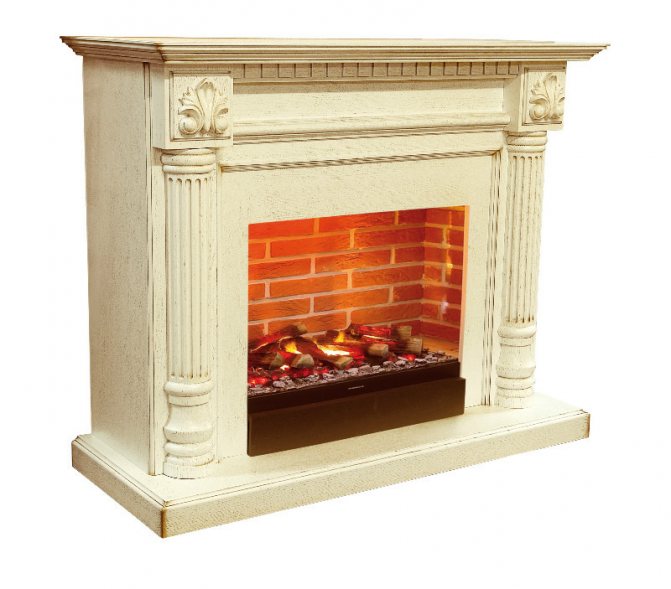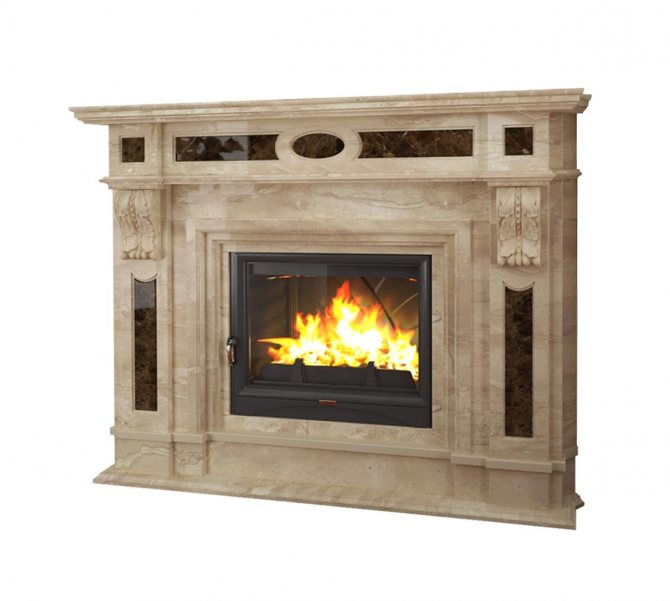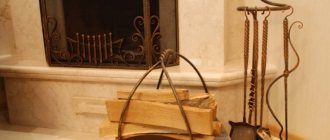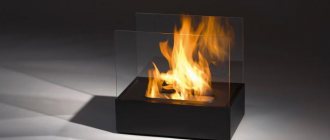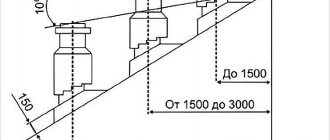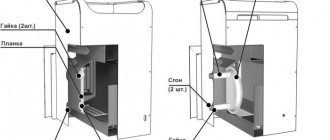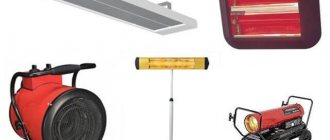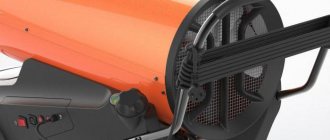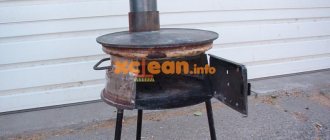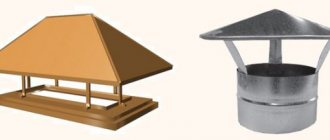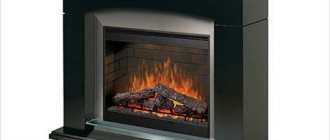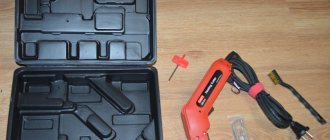How progress has jumped in the building materials market. Now you can install a fireplace and give a touch of comfort even in an apartment. A standard hearth has many nuances in installation: you need to remove the chimney, hire professional builders, in addition, there is a possibility of smoke in the room. It is much easier to install a plaster fireplace portal and recreate an imitation of a hearth. Equipping a decorative fireplace in a house or apartment is not really difficult, using candles or an electric fireplace as heating.
Advantages of gypsum
Gypsum is one of the cheapest and most practical materials for making and decorating false fireplaces. Among its advantages, one can single out environmental friendliness: therefore, gypsum products are completely safe for health. The substance is able to saturate too dry air in the room with moisture, taking it back when it is too humid. With the help of refractory plaster, you can finish real fireplaces with a live flame.
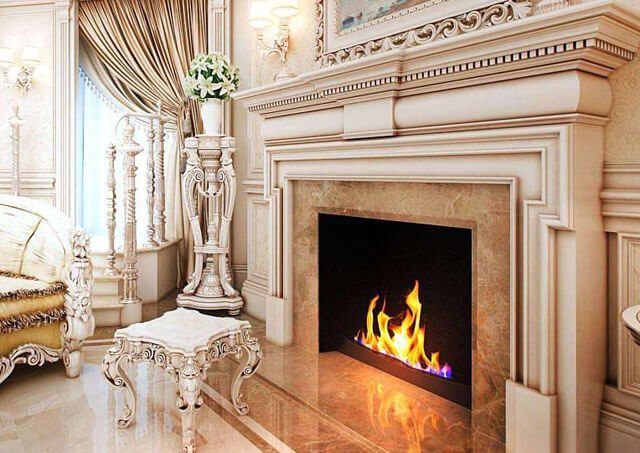

The surface finishing of decorative plaster fireplaces is facilitated by the plasticity of the material. For external decoration of the fireplace portal, decorative elements are often used, selected for a specific interior style. Gypsum fireplaces are characterized by a wide variety of artistic treatments. Any color can be reported to him, for which water-based or acrylic paint is used. You can also make imitations of various natural materials - wood, marble, limestone; cover with gilding or use alfrey painting.
Views
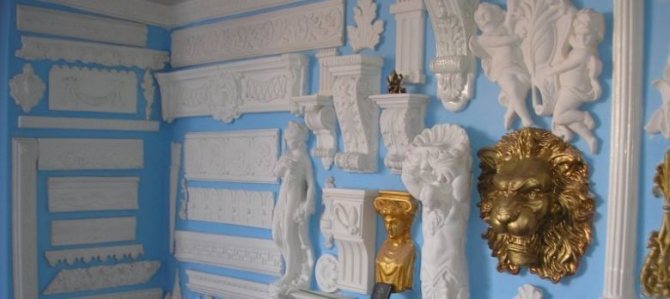

Variants of decorative elements from stucco
Stucco molding can be made from various materials, natural or synthetic. In addition, if you wish, you can make details in a shape resembling a natural stone. For a better match with the interior, the produced fragments can be painted in a suitable color.
The main materials for the manufacture of decorative elements are:
- Gypsum,
- Fiber concrete,
- Polyurethane.
Each type has both advantages and disadvantages, therefore, when approaching the choice of parts, it is necessary to study all its properties.
"Stucco molding" in the apartment - "Independent work"
Gypsum
For gypsum, the following advantages are inherent:
- No shrinkage.
- Refractory properties.
- The structure is flexible enough to be poured into any shape.
- When making decor details with your own hands, the blanks used are very pliable, do not crumble or chip off.
- Long service life.
- Moisture absorption.
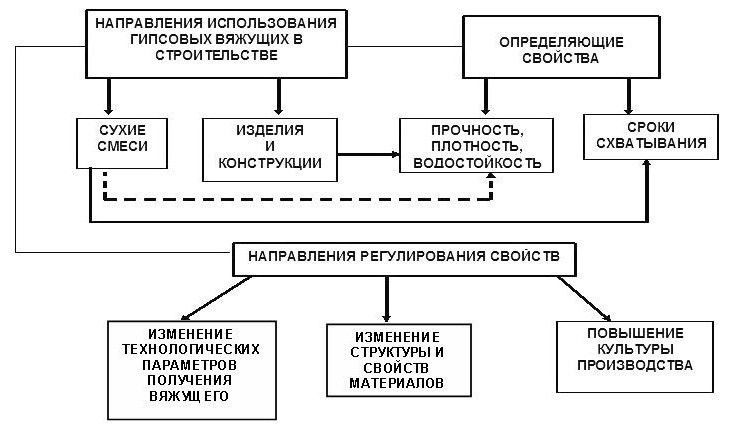

Directions for using gypsum binders
Among the disadvantages are:
- The plaster structure is heavy.
- The finished product is quite fragile.
- In the absence of a polymer coating, gypsum parts can only be cleaned dry.
- Quite a high price.
- Self-fabrication of the portal from plaster is almost impossible.
Fiber concrete
Fiber concrete is a type of concrete based on reinforcement.
Among the advantages of the material are:
- Manufacturing of any parts.
- It has excellent contact with color schemes, resulting in elements similar to natural stone.
- The strength of the finished product.
- Durability.
- Not exposed to moisture.
Polyurethane
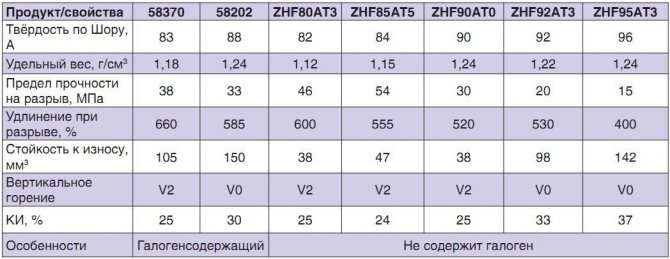

Types of thermoplastic polyurethane
Polyurethane is a synthetic material. Despite the fact that manufacturers claim that it is harmless to humans, many people prefer to avoid it.
Advantages of the material:
- Low weight of the structure.
- Ease of care.
- Resistance to mechanical stress.
- Material properties make it possible to manufacture any elements.
- The surface is perfectly paintable.
- Has a smooth surface without pores, which prevents dirt.
- Resistant to moisture.
- Strength.
- Durability.
- Safety for humans.
Construction of a decorative fireplace from a ready-made portal
Most often in modern interiors you can find plasterboard false fireplaces. In the absence of experience with drywall, a symbolic hearth from a gypsum portal is used to decorate a house with their own hands. A wide selection of specialized shops present a variety of sculptural blanks, with the help of which you can ideally complement the classic interior.
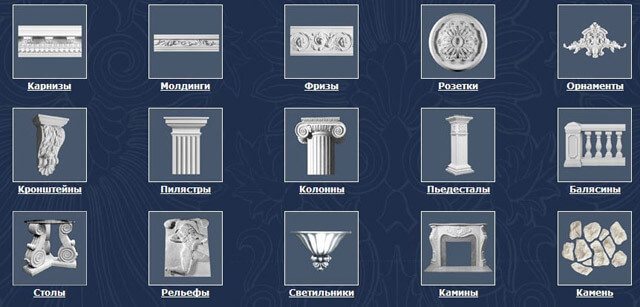

No special professionalism is required to transform a ready-made plaster fireplace portal into a spectacular decor. The easiest way is to fix the portal that you like and suitable for the design on the wall, followed by its finishing. To install the plaster blank, the kit includes the appropriate fasteners. Since during the installation of the gypsum portal, no additional load is created, therefore, any room is suitable for creating an imitation of the hearth. In this case, you can not worry about the safety of the floors.
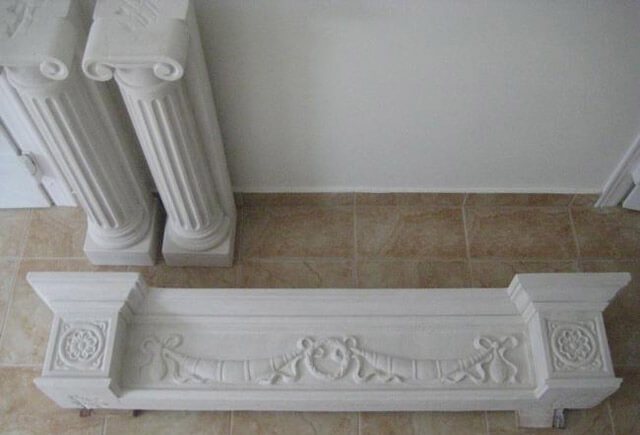

It is easy to tell the blanks any color, including the so-called. "Aging" of the surface. Dyes that create imitation of marble and wood fit well on gypsum. It is easy to apply gilding or art painting to the base. 3D images of the flame look especially impressive inside the furnaces. From the inside, the symbolic firebox can be decorated with the illumination of safe LED candles. To achieve the maximum decorative effect, it is recommended to decorate the interior of the product with a different material than the walls. The imitation of brickwork, made with tiles, looks very nice.
Stucco molding and what it is
Details or figures made with embossed patterns are suitable for the concept of "stucco molding". Such fragments can be made in several ways, one of which involves pressing, and the second method is casting. In one case or another, the resulting decor details can be used both for external facades and for internal rooms.
It is made both on an industrial scale and at home. The second option is more expensive, since you will have to pay extra for the development of the sketch and the manufacture of the form. On an industrial scale, the production of standard parts is envisaged, so the price is quite affordable.
Decor selection
Gypsum is very convenient for performing an author's plot in any style or copying works of famous sculptors. Decorating a plaster fireplace yourself will give the room a special charm. When choosing a design style, the existing interior design of the room and its dimensions are taken into account.
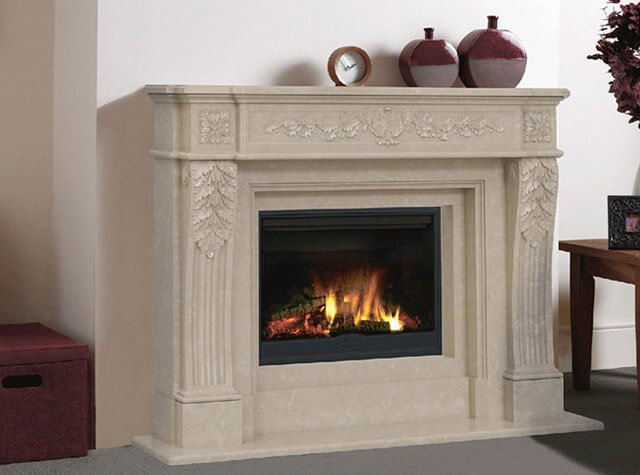

Due to the plasticity of gypsum, it is easy to make various shapes and patterns from it. This is especially suitable for creative individuals who love to create something with their own hands. For admirers of strict symmetries, ready-made elements are offered, sold in specialized stores.
How to make a plaster portal with your own hands
Portal decoration is a very important task that must be done especially carefully. Motifs created with your own hands will give the room a special gloss, individuality and charm, so it is worth learning a few simple rules that will help you do everything right and with pleasure.
Choice of decorative elements
Create your own plot in any style or copy elements of famous sculptors - all this can be done using plaster. A portal decorated to your own taste will have a special charm.When choosing a style, it is worth considering the interior design of the room, its size. Gypsum is a fairly plastic material, so it is very easy to form a variety of shapes and patterns from it. Lovers of creativity can independently create all the details. Those who prefer strict symmetry can use ready-made elements, they can be bought in specialized stores.
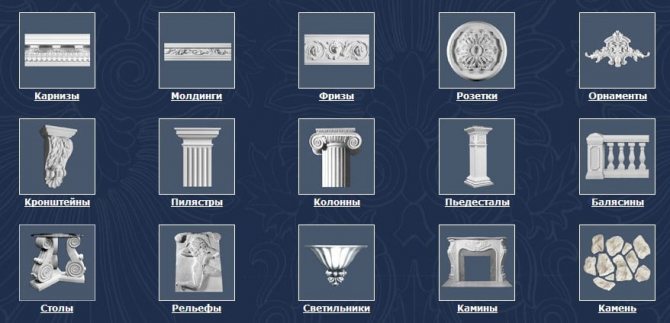

Types of ready-made plaster fragments for portal decoration
Preparation of the solution
To form elements from gypsum, you may need a solution of different consistency:
- For slurry: 1 kg of dry gypsum per 800 mg of water.
- For medium consistency: 1.5 kg of gypsum powder per liter of water.
- For thick mass: dilute 2 kg of gypsum in 1 liter of water.
Note! To form large sculptures, it is worth preparing the solution in small portions. To fill in a form with small fragments and fine reliefs, it is recommended to use a liquid mass, it penetrates better into all recesses.
Plaster molding molding
- Using a stencil or freehand, draw the outline of the future figure on the walls of the portal.
- Apply the plaster mortar evenly, gently spreading and rubbing it around the edges.
- We form plaster "mounds" on the places indicated by the contours. We carefully remove unnecessary elements.
- After the material has completely dried, we carefully grind the element.
Complex multi-component elements will have to be molded in special shapes.
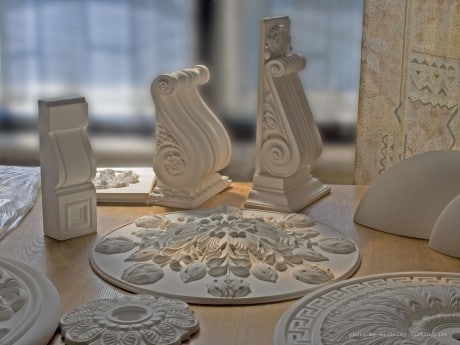

For the manufacture of complex parts, it is better to use special shapes.
Expert advice: before filling the mold with plaster mass, it must be treated with a water-soap solution, this will facilitate the extraction of the figures. The solution should be poured in stages, the thickness of each layer should be no more than 1 cm.
Making and decorating a false plaster fireplace with your own hands is certainly a very exciting and entertaining event. However, in the course of work, you may have difficulties using a solution of different consistency for decorative parts, it is also quite difficult to make a completely symmetrical pattern, if this is the goal. You can insure against all sorts of disappointments and problems by contacting professionals who will certainly be able to make all your dreams come true.
Plaster molding
In the manufacture of plaster moldings, the following sequence of operations is observed:
- Drawing on the walls of the portal the outlines of the future figure. This can be done by hand, or through a stencil. When applying the gypsum mixture, it is important to maintain uniformity: it must be carefully distributed and rubbed around the edges.
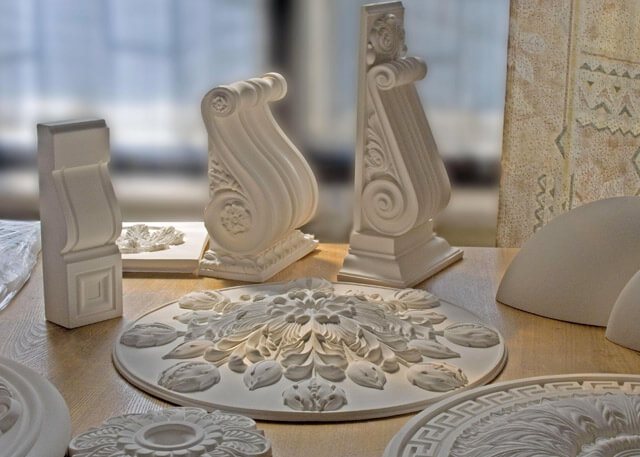

- Formation of gypsum "mounds" in the areas indicated by the drawing. All protruding excess is carefully removed.
- Grinding. It can only be performed after the gypsum solution is completely dry. To do this, use painting sandpaper No. 160-200. If the surface is treated "wet", ugly furrows will appear on it. During grinding, it is advisable to protect the respiratory system and eyes from fine dust.
Advantages of plaster fireplace decor
- Gypsum is an impeccable solution in terms of environmental friendliness of the material and its non-shrinking qualities.
- Such stucco molding has fireproof characteristics, which allows it to be used safely in a residential area.
- Gypsum cladding is durable, does not contain toxic components and does not have any odor, so that its use does not harm the comfort of a person's stay near the hearth.
- This material has moisture-absorbing properties.
- Gypsum stucco molding does not conduct electricity, its decoration is safe for all family members.


Additional recommendations
To facilitate the procedure, it is recommended to enlist the advice of specialists:
- Manufacturing of multi-component elements of increased complexity is simplified by using special shapes.
- In order for the figures to be removed from the forms as easily as possible, it is advisable to grease them with a water-soap solution.
- When pouring the mixture, it is advisable to observe the phasing. Recommended thickness of one laying is no more than 10 mm.
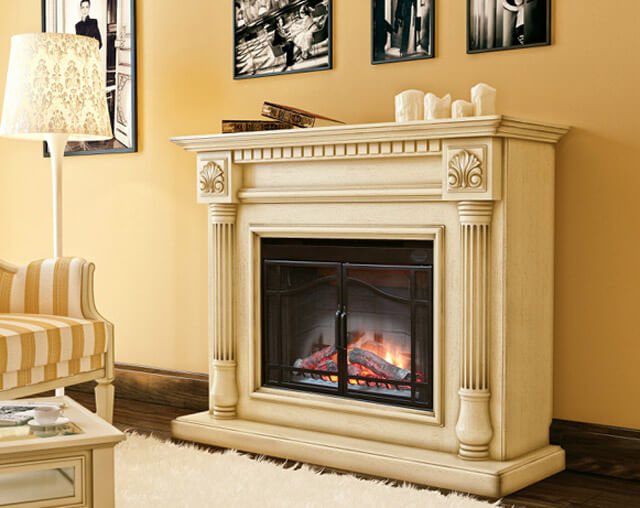

Self-production and decoration of false plaster fireplaces is a very exciting activity. In the course of work, the main difficulty arises when using a mixture of different levels of density. Another tricky moment is to achieve a completely symmetrical pattern.
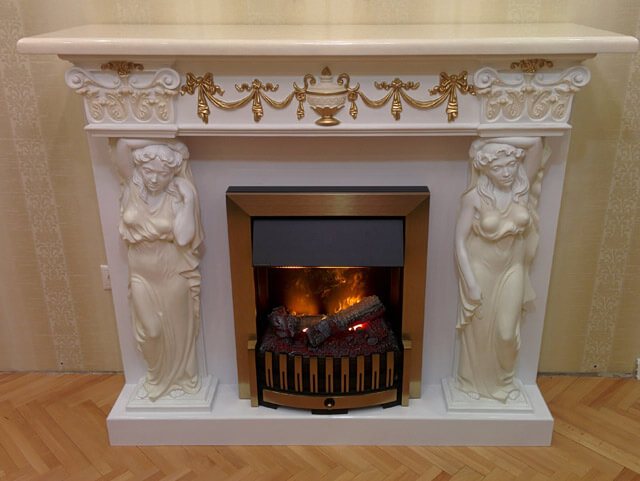

In the absence of proper experience, you can turn to experienced craftsmen who can complete the project you like. If you do not like any of the ideas for decorating a plaster portal for a fireplace available in the catalog, there is an option with numerous Internet resources specializing in the appropriate decor.
We dance from the stove
Any construction begins with a project, and before building a fireplace, you need to decide on the installation site, appearance, dimensions and materials for the work.
Fireplace types
A false stucco fireplace can be made of the following types:
- Reliability - this type completely repeats a real fireplace, with the exception of the chimney. An electric or biofireplace with an imitation of a flame is mounted in the firebox; wood, clinker brick or tiles, gypsum stucco molding, natural or artificial stone are used in the decoration.
- Conventional - represents a portal of small depth, decorated in the image of real fireplaces, but without a flame. The space of the firebox is occupied by a decorative woodpile, candles, bookshelves and even ornamental plants.
- Symbolism - an image painted on the wall, only a hint of the fireplace portal - a silhouette without depth, it is easiest to accomplish it using ready-made moldings or baseboards.
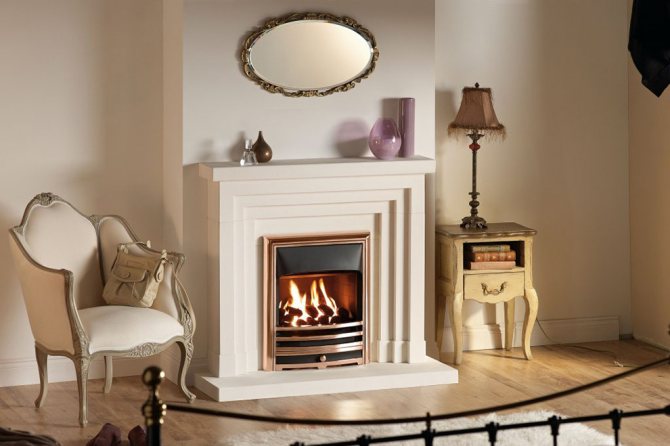

Fireplace type - reliability
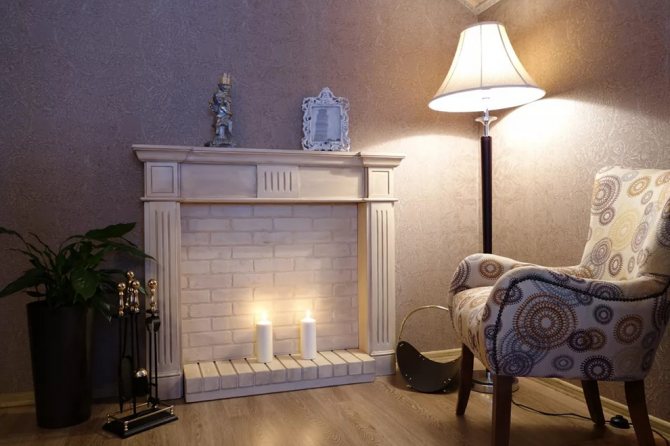

Fireplace type - convention
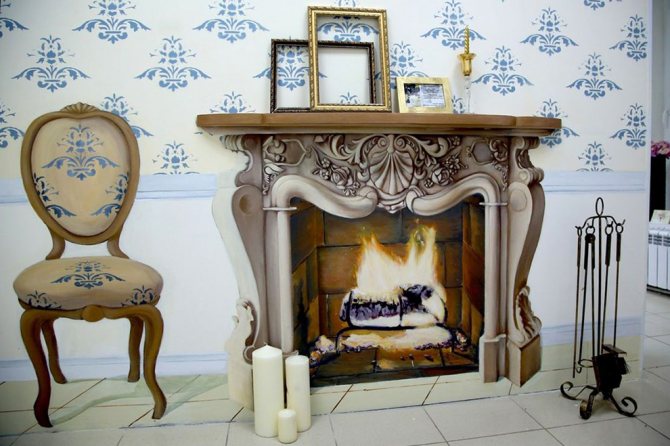

Fireplace type - symbolism
The device of a reliable fireplace will require wiring and additional ventilation, and this is a significant financial cost. A conventional fireplace with a beautiful portal is no less decorative than a real one, although it will not give warmth. The symbolic one is more suitable for a children's or youth interior, it is the easiest to complete. The choice is up to the owner of the apartment.
Place of installation
When choosing a place for a fireplace, you need to take into account the area of the room, the purpose, layout and arrangement of furniture:
- In a small room, the fireplace can be made in a corner, so it will take up very little space.
- In a spacious room, it can be made the center of the composition in a recreation area with a soft group, and the fireplace can be located both in the center of the hall and at one of the end walls.
- Another option is a mobile fireplace, when the portal is mounted on a platform and can be moved at will from place to place and to other rooms.
For a presentable room - a common room, a spacious hall, a living room, the central composition is suitable. In a small office or bedroom of a limited area, a corner hearth is preferable. If you have only one studio room at your disposal, and you still want to have a fireplace, then a mobile device will be the best solution.
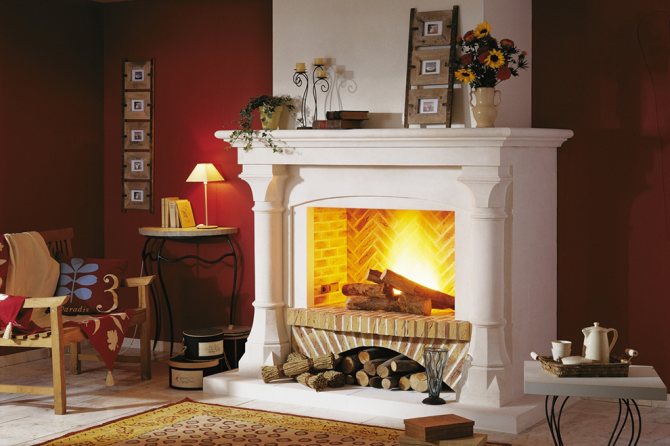

Plaster fireplace in the interior
Style, texture, color
The style of the structure depends on the overall solution of the interior, however, in a small room, a fireplace overloaded with details will not look large-scale, making the space even more cramped. In a spacious room, a small fireplace will be lost and will not make the proper impression.
Stucco moldings for the fireplace should repeat the style of decoration:
- The ancient Egyptian design corresponds to powerful, with angular lotus capitals, half-columns or pylons in the form of characteristic Egyptian sculptures, the color is sandstone, turquoise, lapis lazuli, ebony.
- Ancient Greek or Roman motives correspond to the capital of the classical orders: Doric, Ionic, Corinthian, composite.The mantelpiece is supported by Atlanteans, caryatids, satyrs. The texture of the stucco molding is marble.
- The era of the Middle Ages - the Gothic, Romanesque style is distinguished by simple forms and primitive processed stone - sandstone, limestone, without detailing. The decoration features frequent floral motifs - lilies, roses, fantastic creatures - chimeras, dragons, gargoyles.
- The centers of the Renaissance, Baroque and Rococo are marked by a return to ancient traditions and a gradual complication of drawing and molding, an abundance of ornaments, curved lines, torn cornices. Attention is drawn to the bright color, gilding or silvering of details, facing with a rich-colored stone - jasper, onyx, malachite.
- The classicism and empire style fireplace harmoniously combines the traditions of Ancient Greece and Rome with the refined baroque decor without the pretentiousness of the rococo. The fireplace becomes the compositional center of the decoration - the mantel serves to demonstrate the rarities, above it is a mirror in a precious frame or a picture of a famous master.
- Modern or Art Nouveau fireplaces are more modest in size, often made of black metal or clad in dark wood. Typical decoration - wood carving, plaster molding or molding depicts favorite lilies, irises, whimsical interweaving of geometric ornaments.
- In the modern style of postmodern, hi-tech, techno, bionic architecture, the fireplace loses its functionality due to the emergence of new types of heating, becomes a sign of luxury and romance. It acquires a dynamic form, and closed fireboxes make it safe. A variety of materials and surface treatments make the modern hearth unique.
For small rooms of standard housing, the style of modern classics is best suited - a modest and at the same time sophisticated design will make the room more comfortable, and will demonstrate the excellent taste of the owners to the visitors.
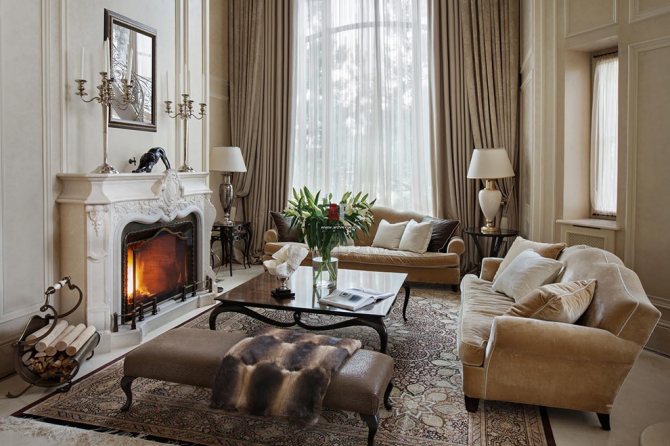

Classic style fireplace
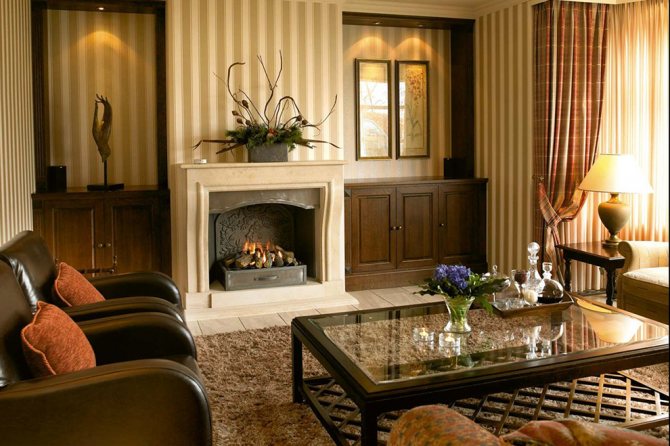

Classic style fireplace
Materials for the device of the fireplace
Plaster stucco molding for the fireplace is the final stage, decoration. Prior to that, the functional type, size and location of our structure must be determined, as well as the material from which the structure will be made. The fireplace portal can be made from the following materials:
- Brick - has a significant weight (1350 kg / m3 without mortar with a permissible floor load of 600-800 kg / m3), requires dismantling the floor under the fireplace and installing it on the foundation, and therefore you should not make a brick fireplace in a multi-storey building, even if you live on the 1st floor.
- Lightweight concrete blocks - gas silicate, expanded clay, arbolite have a weight 3-4 times less than a brick, but such a structure is not recommended to be installed on a clean floor.
- Metal or wooden frame, sheathed with gypsum plasterboard, glass-magnesia (MSL) sheets, chipboard, fiberboard, OSV, plywood. The most common and economical option. If an electric fireplace is chosen, then it is better to make the cladding for fire safety purposes from fire-resistant drywall in 2 layers or LSU.
- Cardboard boxes are the easiest option, but cardboard stucco molding is not suitable for a false fireplace, it will not withstand the significant weight of the material.
Rejecting bricks and lightweight concrete blocks due to the large weight of the structure, and from cardboard as an insufficiently strong material, we leave the only possible option for a molded gypsum fireplace - a portal made of a metal or wooden frame, sheathed with durable, fire-resistant material.
Design
Having considered the possible options, we stop at a false fireplace decorated with candles, with a portal made of a galvanized metal frame, sheathed with LSU of Standard class with a thickness of 8 to 10 mm. The style is classic, we will do the stucco molding on our own.
We draw on a sheet of paper or in a computer an image of a structure with all dimensions: firebox, separately - the frame of the portal and sheathing, stucco molding.We calculate the required amount of materials according to the drawings. For the inner cladding of a false firebox, you can purchase LSU with a decorative finish for a natural stone or brick - this way you will not need to perform additional painting or cladding of these surfaces.
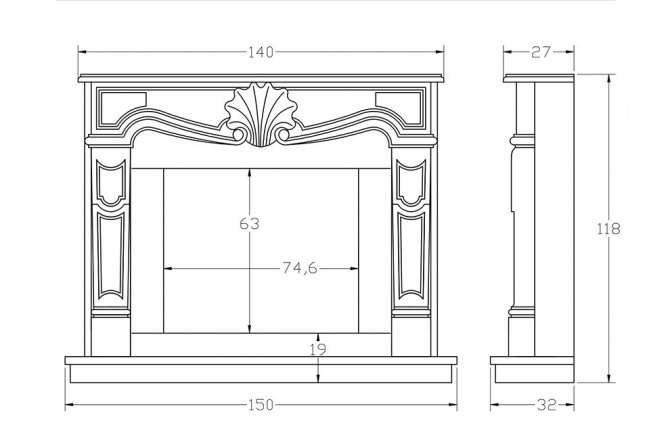

Fireplace drawing
Let's start simple
A frame made of metal profiles serves as the basis for any type of fireplace. Installation involves the assembly of the box. Ultimately, you should have a box, which includes the portal. The wireframe is the main element and therefore requires a thoughtful approach. In order for the portal frame and the entire box as a whole to be assembled as needed, it is necessary to draw a drawing of the entire structure. You can do this with your own hands, or take a ready-made drawing. The drawing in this situation should have the following parameters:
- dimensions (height, length and width) of the base of the fireplace;
- similar portal parameters. Only in this case, the width should be changed to depth;
Note! To correctly determine the depth of the portal, you must first buy a device that will simulate fire. Otherwise, the device purchased after the assembly of the structure may simply not enter the portal. In such a situation, you will have to expand it, and this will be costly and not a very pleasant pastime. In addition, the frame will have to be redone.
- top shelf parameters.
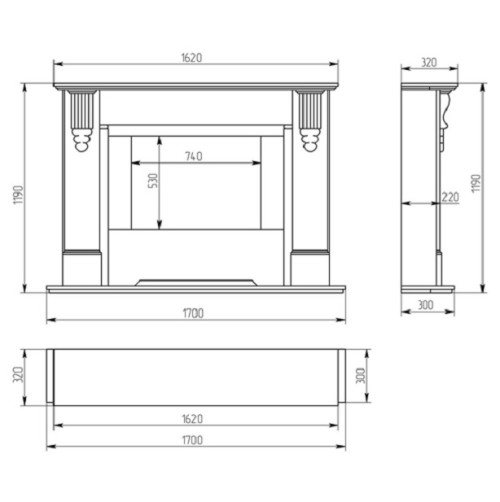

Portal Blueprint
Also, here you should take into account the weight that the top shelf will withstand. When placing books or other heavy objects on the fireplace, this element and the box in its upper part must be additionally strengthened.
Varieties of portals
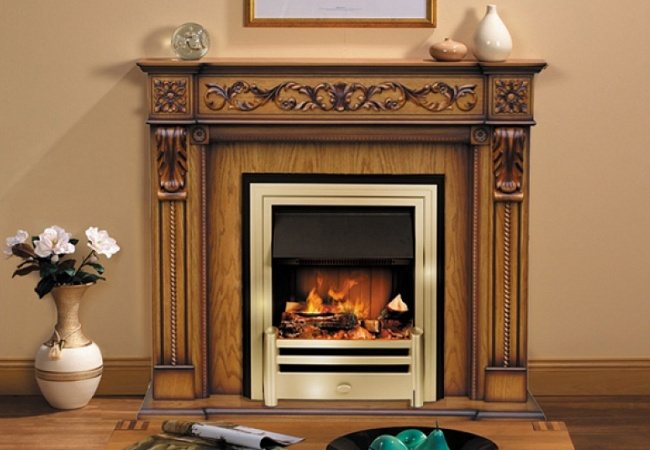

Portals may vary in style and materials of manufacture
Fireplaces are complex devices, they are responsible for choosing an option for buying or making it yourself.
At the design stage, it is determined:
- purpose - heating, decorative function, combined option;
- type of energy carrier - firewood, biofuel (ethanol), electricity, natural gas;
- type of allocation;
- the style of the portal;
- type of building material for manufacturing.
Functions and fuel
Devices that are designed for heating can burn wood, coal or gas.
In the conditions of city apartments, the installation of products of this kind is impossible. To remove deadly combustion products and corrosive smoke, a high-performance chimney is needed. Sanitary standards prohibit connecting the pipe to the general access hood. In addition, complaints from neighbors will surely be received, to whom the smoke will get into the house.
Electric fireplaces are equipped with 1.5–2.5 kW heaters capable of maintaining the temperature in a room with an area of 10–18 m2. Considering the cost of electricity, this heating method is extremely expensive. Devices turn on for a short time. Electric fireplaces combine the functions of a decorative element and heating.
To create the illusion of a flame, electric fireplaces are equipped with special bulbs.
Biofuel is obtained from the remains of rapeseed, coconut, soybeans. Ethanol is expensive on sale and it is not profitable for them to heat the room. Fireplaces serve as a decorative element.
Manufacturers add fragrances to biofuels with various odors. Special additives give the flame a natural color, and the sea salt produces a crackling effect.
Installation options
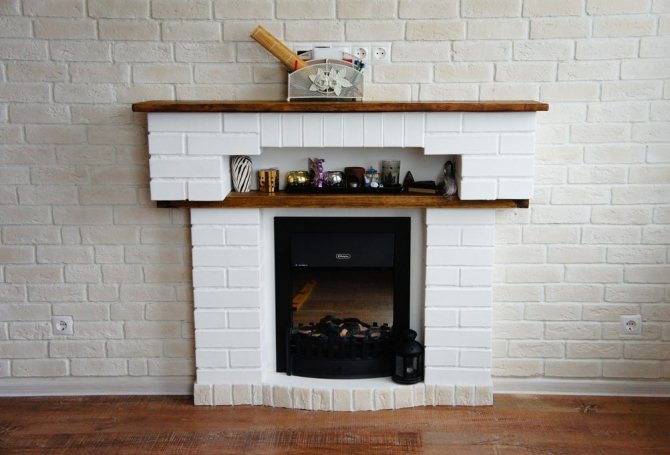

For built-in fireplaces, the portal practically does not protrude beyond the wall line
The choice of model depends on the tasks set, the size of the room, the desired style.
There are fireplaces:
- built-in - they are placed in specially designed niches and recesses, the facade of the portal does not protrude beyond the line of the wall;
- half-open - part of the structure is in a niche, and the front part protrudes into the room;
- corner models are suitable for small premises when it is necessary to economically treat the usable area;
- wall options do not have contact with the floor, the size and weight of such products are small;
- open fireplaces are usually located in the center of the room; they serve as a place around which a large company can gather.
For each option, a portal of the appropriate design is selected.
Let's start assembling
After the drawing has been drawn, you need to choose a location for the fireplace and start assembling it.
Note! The design choice determines its appearance, as well as functional and decorative load. You can decorate a room with a fireplace or completely spoil its appearance.
When the place is chosen, we begin to make a metal frame, at the same time bringing out the box. In this case, the installation of the portal is part of the box. Therefore, they are being built at the same time. The frame is assembled according to the following scheme:
- we first make the floor crate;
- you need to make the base of the fireplace. To do this, first we fix the starting profile, and then insert the profile guides into it;
- profiles on the wall and floor should be fixed with dowels and screws, and between themselves - with self-tapping screws for metal;
Note! Profile parameters depend on the type of structure and the load that it must withstand.
- when the base box is made, go to the portal frame;
- for this you need to make a metal frame with a niche inside. The niche is mounted using standard technology. This niche is sometimes also called the portal tube;
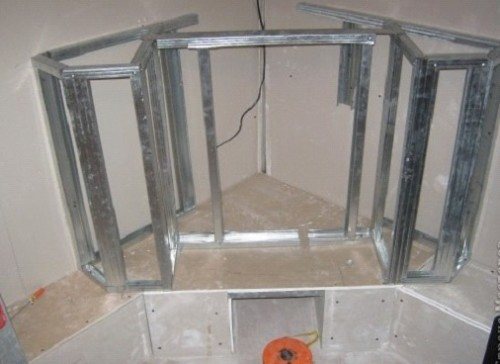

Portal frame
- to give the entire structure rigidity between the guide profiles, we fasten the trimmed rack profiles (lintels);
- you can easily make jumpers with your own hands using metal scissors;
- they should be fastened not only along the perimeter of the portal, but also in the upper shelf.
As a result, the assembled box will have sufficient rigidity to support the weight that you put on the top shelf.


